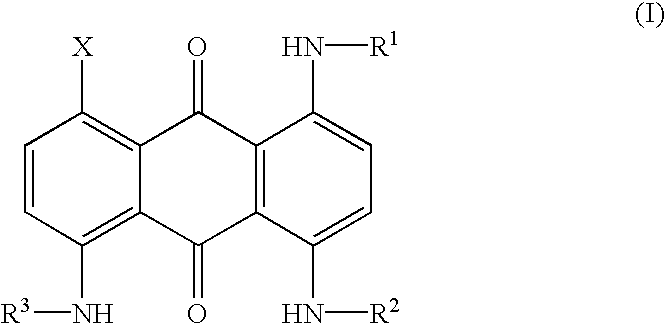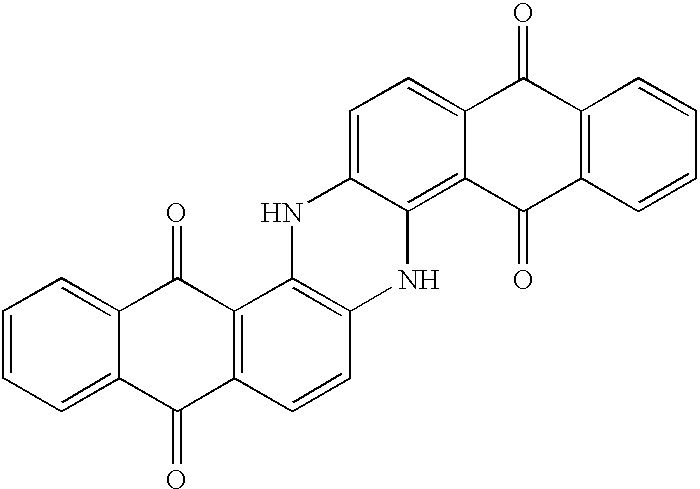Method for marking hydrocarbons with anthraquinones
a technology of hydrocarbons and anthraquinones, which is applied in the field of marking hydrocarbons with anthraquinones, can solve the problems of high cost and difficulty in preparation
- Summary
- Abstract
- Description
- Claims
- Application Information
AI Technical Summary
Benefits of technology
Problems solved by technology
Method used
Image
Examples
example 1
Synthesis of 1,4,5,8-tetra(phenylamino)anthraquinone
A mixture of 10.87 g of 1,4,5,8-tetrachloroanthraquinone, 50 g of aniline, 13.4 g of potassium acetate, 1.24 g of copper sulfate, and 3.41 g of benzyl alcohol was heated to 130.degree. C. under nitrogen and maintained at this temperature for 6.5 hours, followed by another holding period at 170.degree. C. for 6 hours. The reaction mixture was cooled to ambient temperature and the precipitate was filtered to give black solids. Recrystallization of the crude product from toluene afforded 6.0 g of a dark green crystalline material (>95% purity with the structure confirmed by proton NMR as the desired product: 1,4,5,8-tetra(phenylamino)anthraquinone. This material had a maximum absorption band (.lambda..sub.max) at a wavelength of 750 nm in toluene. The molar extinction coefficient (.epsilon.) was determined to be .about.30,500.
example 2
Synthesis of 1,4,5,8-tetra(4-n-butylphenylamino)anthraquinone
A mixture of 10.87 g of 1,4,5,8-tetrachloroanthraquinone and 95 g of 4-n-butylaniline was allowed to react at 190.degree. C. for 12 hours. The reaction mixture was then cooled to 70.degree. C. and diluted with an equal amount of ethanol. On standing and further cooling to ambient temperature, some precipitate was formed. The mixture was filtered, washed and recrystallized from xylenes / isopropanol to give 6.6 g of a dark green crystalline material (>95% purity) with the structure confirmed by proton NMR as the desired product of 1,4,5,8-tetra(4-n-butylphenylamino)anthraquinone. This material had a maximum absorption band (.lambda..sub.max) at a wavelength of 762 nm in toluene. The molar extinction coefficient (.epsilon.) was determined to be .about.36,900.
example 3
Detection of Dyes in Petroleum Hydrocarbons
Solutions of 1,4,5,8-tetra(phenylamino)anthraquinone (TPAAQ) in xylenes, Texaco.TM. diesel fuel and Mobil.TM. regular gasoline at varying concentrations were prepared and analyzed with a laboratory spectrophotometer. The results are presented in the Table below, with expected and actual readings expressed as a percentage of the reading for 1 mg / mL.
PUM
| Property | Measurement | Unit |
|---|---|---|
| temperature | aaaaa | aaaaa |
| temperature | aaaaa | aaaaa |
| chemical | aaaaa | aaaaa |
Abstract
Description
Claims
Application Information
 Login to View More
Login to View More - R&D
- Intellectual Property
- Life Sciences
- Materials
- Tech Scout
- Unparalleled Data Quality
- Higher Quality Content
- 60% Fewer Hallucinations
Browse by: Latest US Patents, China's latest patents, Technical Efficacy Thesaurus, Application Domain, Technology Topic, Popular Technical Reports.
© 2025 PatSnap. All rights reserved.Legal|Privacy policy|Modern Slavery Act Transparency Statement|Sitemap|About US| Contact US: help@patsnap.com



